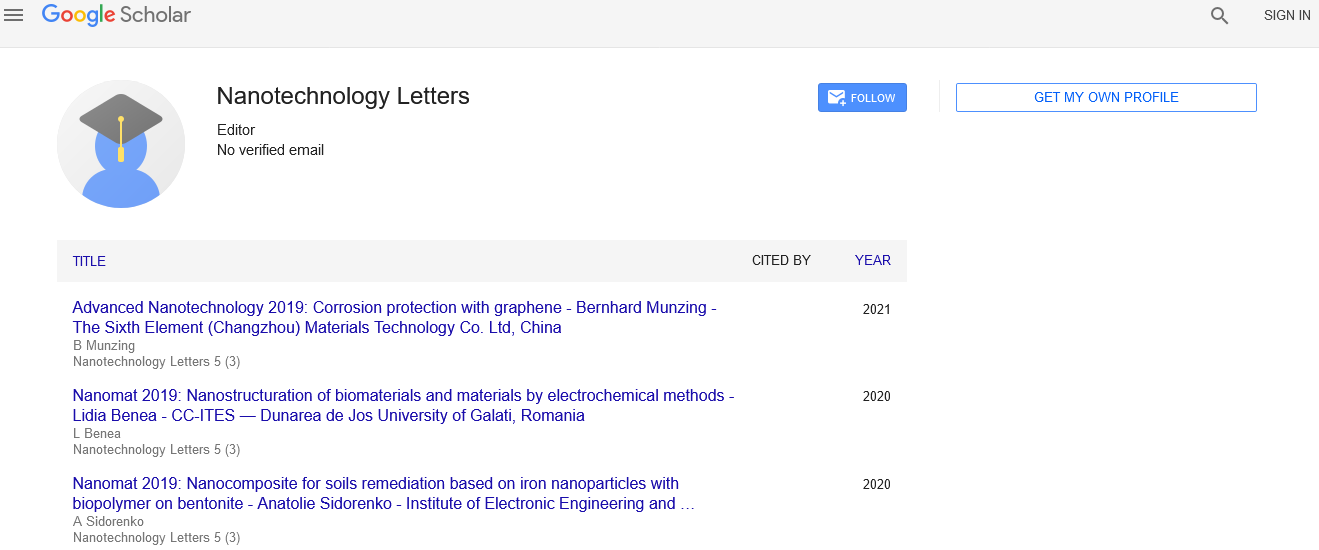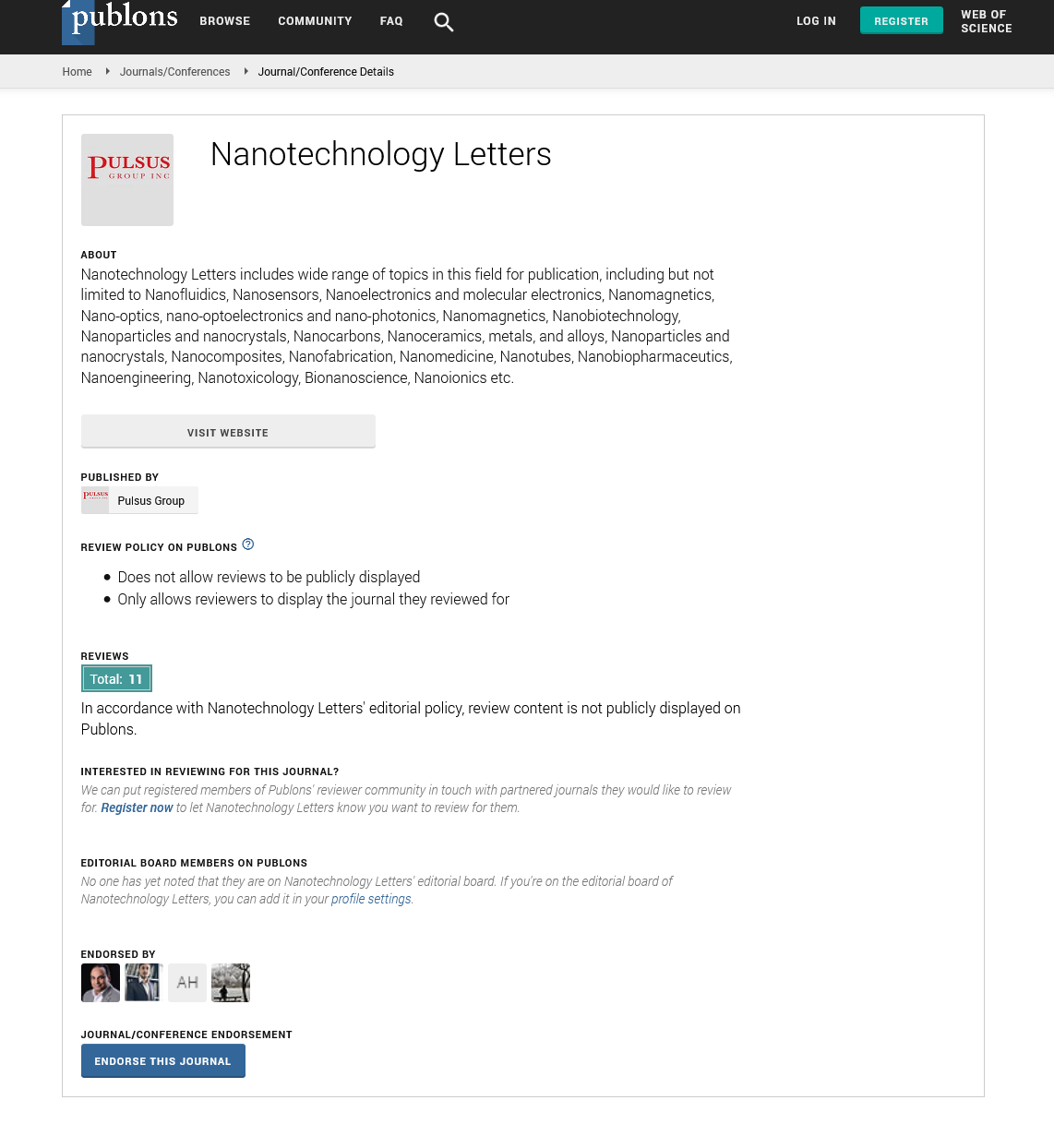Role of nanomedicine in drug delivery
Received: 05-Jul-2022, Manuscript No. PULNL-22- 5599; Editor assigned: 07-Jul-2022, Pre QC No. PULNL-22- 5599 (PQ); Accepted Date: Jul 27, 2022; Reviewed: 13-Jul-2022 QC No. PULNL-22- 5599 (Q); Revised: 19-Jul-2022, Manuscript No. PULNL-22- 5599 (R); Published: 28-Jul-2022, DOI: 10.37532. pulnl.22.7 (4).10-11.
Citation: Shukla T. Role of nanomedicine in drug delivery. Nanotechnol.lett.; 7(4):09-10
This open-access article is distributed under the terms of the Creative Commons Attribution Non-Commercial License (CC BY-NC) (http://creativecommons.org/licenses/by-nc/4.0/), which permits reuse, distribution and reproduction of the article, provided that the original work is properly cited and the reuse is restricted to noncommercial purposes. For commercial reuse, contact reprints@pulsus.com
Abstract
A subfield of medicine known as nanomedicine employs applied science to prevent and treat disease within the body. This rapidly developing field has the potential to significantly alter life science. In order to perform examination, conveyance, identification, or incitation tasks in a very living structure, nanomedicine combines the utilisation of tiny materials, such as biocompatible nanoparticles and nanorobotsUnderstanding the issues related to morbidity and the environmental effects of nanoscale materials, as well as the creation and use of nano-prescriptions, are current challenges for nanomedicine. With a focus on the synthesis, functionalization, and beneficial applications of such nanoparticles, research is currently being done to give a wide range of magnetic nanoparticles, silver nanoparticles, and gold nanoparticles.
Key Words
Nanomedicine; Nanodrugs; Drug delivery
Nanodrugs
Nanoparticle medicines Energizing progress in the de novo design of nanosized pharmaceuticals has joined astonishing advancements in nanotechnology and nanoscience. Nanoparticles have proven to be the ideal candidate for high viability nanomedicines in both diagnostics and treatments due to their wide range of structural amenability and remarkable mechanical and electrical capabilities. Nanoparticle drug delivery for conventional medications and Nano drugs and nabobs with coordinated cure of target ailments are two further classifications for the therapeutic nanomedicines. There are three broad categories for nanomolecules. Nanoparticles of one, two, and three dimensions are made using various fabrication processes. Nano drug design challenges include the drug loading and dispensing system, as well as its limitations and safety concerns.
Drug delivery and device development
Drug delivery techniques and the usage of medicinal devices both continue to develop and spread. Drug delivery devices are specialised equipment used to provide a medication or therapeutic ingredient through a predetermined route. These tools are employed in the vicinity of one or many medical treatments. For drug delivery via the viscus and nasal routes, there are a number of medical devices. In addition to quick medication delivery to the system circulation and direct delivery to the central system, these routes are of interest for native delivery, as in the case of respiratory disorders.
Drug Targeting
The primary goal of drug design is to predict with certainty whether or not a given particle can bind to a target. When small molecules are bound to biological targets, molecular mechanics or molecular dynamics are frequently used to forecast the conformation of the small particle and to model conformational changes that will take place there. A drug's therapeutic effect depends on the drug molecules' ability to cooperate with biological processes at receptor sites connected to cell-on-plasma membrane biological events in a concentration-dependent manner.
Drug delivery system
Medicine delivery is the process of controlling the drug or pharmaceutical product in order to achieve the desired therapeutic effect. The method of drug delivery is crucial since it significantly affects how effective the drug is. Combining chemical science, pharmacy, and biology is a component of a novel drug delivery system (NDDS). Physical and organic chemistry pathways are made public by novel drug delivery devices. Dissolution, osmosis, diffusion, and other physical mechanisms are included in controlled drug delivery systems. Drug delivery systems (DDS) examples include cistron medical aid, liposomes, nanoparticles, being antibodies, macro emulsions, and so on. Drug delivery techniques include transmucosal, sonophoresis, lymphoid, in situ, micelle, emulgel, and gel.
Drug Delivery Equipment’s and Machinery
Laboratory equipment, analytical equipment, automobile injectors, semi-automatic equipment for research and development, large-volume production machines, and hardware for drug delivery pilot projects are all included in the equipment and machinery for drug delivery. This field is developing quickly. The market for medication delivery technology is anticipated to reach USD 1,504.7 billion by 2020, up from USD 1,048.1 billion in 2015,expanding at a CAGR of 7.5%. The prevalence of chronic diseases is increasing, the biologics market is expanding, new products are being introduced, new drugs are being developed, and technology is progressing, all of which are driving this industry's growth. On the other hand, patent cancellation and issuance, an increase in harms and side effects, and patent development all impede the growth of this market.
Analysis of Drug delivery
Drug delivery refers to the strategy used by a nurse practitioner to deliver medications or other xenobiotics to their sites of action inside an organism with the intention of obtaining a therapeutic result. Drug delivery must take into account pharmacodynamics and material medico space issues. developing new drug delivery methods while keeping an eye on how they can be used to treat disease situations. The designation of medication delivery systems and clinical data related to them. To show practical results, drug distribution, Materia Medica, clearance, and modern drug delivery systems are used instead of traditional dosing. Drug delivery systems' short- and long-term biocompatibility, host response. Biomaterials containing growth factors for tissue engineering and regenerative medicine stem cell differentiation. Drug delivery devices and products that combine both drugs and devices.
Major Challenges in Drug Delivery
Major Challenges in Drug Delivery Systems include the delivery of poorly soluble medications, bioavailability barriers for poorly solvent clinical candidates, super molecule drug delivery, medication, and geriatric drug delivery. There are a number of organic chemistry boundaries that may interfere with the effective delivery of drugs. SEDDS have unparalleled potential for improving the oral bioavailability of medications that aren't easily soluble. There are a number of novel methodologies for delivering medications, overcoming bioavailability barriers, and formulating medications that are not readily soluble. there is rising interest in drug delivery methods that are efficient and, ideally, non-invasive. Currently, biopharmaceuticals account for about 20% of the market for pharmaceutical companies and produce $163 billion in international sales. It is by far the fastest-growing sector of the industry; biopharma's current annual growth rate of over 8% is twice that of the average pharmaceutical company, and it is predicted that growth will continue at that rate for the foreseeable future.






